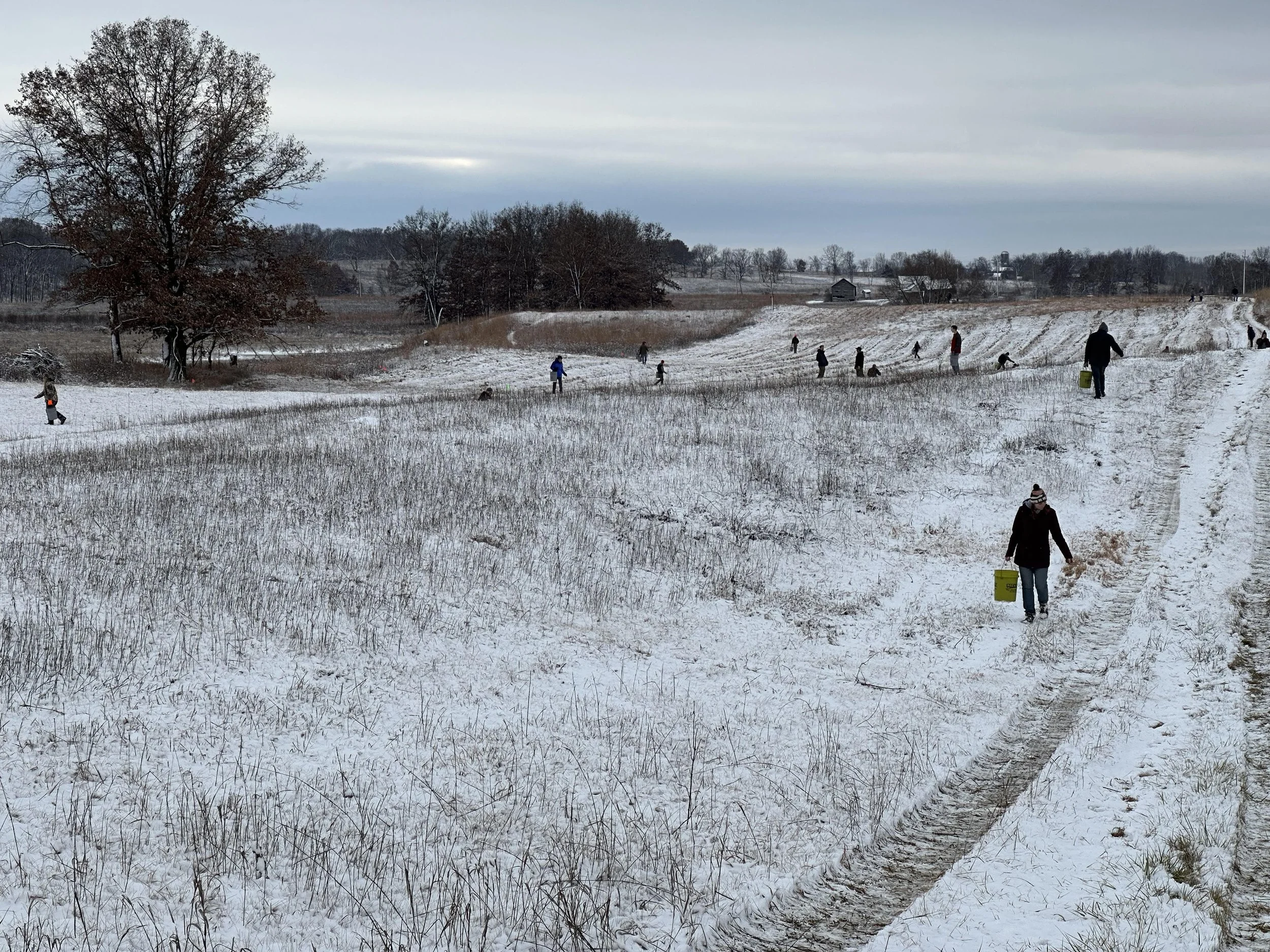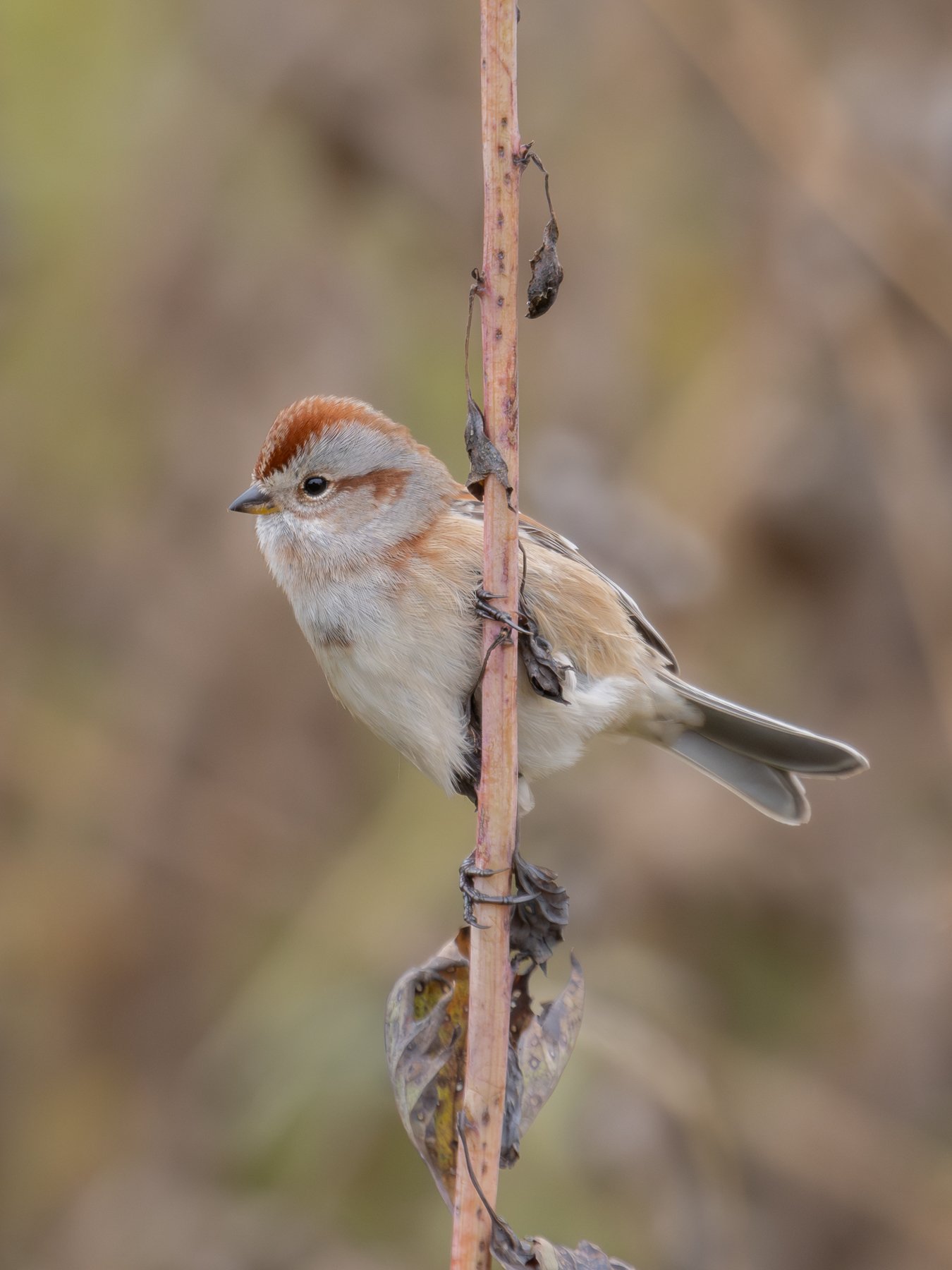This season at the sanctuaries: winter 2023
Southern Wisconsin Bird Alliance’s lands are permanently protected and conserved habitat for birds, plants, and other wildlife. They are stewarded, restored, and managed by our sanctuary teams. Faville Grove and Goose Pond are open for all to visit and enjoy. Learn more here.
Preparing for planting at Goose Pond
A volunteer assists with a prescribed burn in November 2022 (photo by Kaitlin Svabek/SoWBA).
Fall is a busy time at Goose Pond Sanctuary! We have now wrapped up our 2023 seed collection season with seed from 197 native species, including species that are federally-threatened, state-threatened, or state-endangered. Soon it will be time for winter planting, and we will sow these seeds on nearly 50 acres at the sanctuary and partner lands this winter.
All of the native prairie plantings at Goose Pond Sanctuary provide excellent habitat for birds and other wildlife, but they do not necessarily mirror historic Wisconsin prairies. Planted prairies can be lacking in spring flowers and native cool season grasses. Generally, fall burning invigorates both, so we’re trying to put a stronger emphasis on that. This season we burned about 102 acres of prairie, savanna, and woodland habitats, which will be excellent future seed collection spots for shooting star, cream baptisia, alum root, and other spring species.
And of course, volunteers are crucial in both our seed collection and prescribed burn efforts, thank you so much to everyone who has joined us to help!
Plan your visit
A domestic goose, or possible Canada Goose x domestic hybrid, comes in for a landing at Goose Pond Sanctuary in November 2023 (photo by Arlene Koziol).
Despite low water levels this fall, plenty of waterfowl migrated through in large numbers, with over a thousand Canada Geese regularly counted. In the mix, a large white domestic goose, or possibly a Canada Goose x domestic goose hybrid also showed up this fall, a first at Goose Pond. In November, 50–145 Tundra Swans were seen feeding on arrowhead (also called duck potato) tubers and a large number of Sandhill Cranes passed by on their way south.
Winter can be a quieter season, but it is always interesting to see who appears on the Pond Cam. Seasonal visitors like Lapland Longspurs and Snow Buntings can now be found in the area, and Rough-legged Hawks have recently returned (read more in our recent Friday Feathered Features). We are looking forward to seeing if Snowy Owls will show up at Goose Pond this year.
For more information, check out the Goose Pond Sanctuary map or take a virtual tour via the Goose Pond StoryMap.
Get involved
Goose Pond Sanctuary co-managers Mark Martin and Susan Foote-Martin have been coordinating the Poynette Christmas Bird Count since 1981. This year, it will take place on December 30. You can learn more or sign up to join here.
If you’d like to join in for winter planting or be added to Goose Pond’s volunteer email list, contact land steward Graham Steinhauer at gsteinhauer@swibirds.org.
Learn more:
If you have questions or would like to receive Goose Pond updates more often, email goosep@swibirds.org
Settling in for winter at Faville Grove
A newly-built Bald Eagle nest at Faville Grove Sanctuary (photo by David Musolf).
When leaves drop in the fall, it’s always fun to find abandoned bird nests from the previous season that have been hiding all summer long. But imagine our surprise to find a nest under construction as the leaves fell from a large cottonwood tree in the southwest corner of the sanctuary—with a pair of Bald Eagles ferrying sticks as we watched. In order to minimize disturbance to the eagle pair during the nesting season (January through June), we can’t share the exact location of the nest. But if you are out enjoying the sanctuary and spot it, please stay back at least 300 feet—eagles will abandon their nest if they perceive disturbance.
We’ve been busy spreading the seed collected by summer interns, fall volunteers, and sanctuary staff. In early December, thirty volunteers planted nine acres of upland prairie on a fresh layer of wet snow. Following a late-season controlled burn on nine acres of oak woodland, including part of the newly acquired 80-acre tract on the east side of Faville Marsh, we hand-broadcast seed of a diverse mix of species that find themselves at home in light shade, and we spot-seeded other savanna and woodland areas in many dozens of small patches cleared of leaves using a backpack blower. Finally, we’re planting wetland edges throughout the sanctuary where we applied herbicide to invasive reed canary grass last summer.
Plan your visit
A Short-eared Owl perches on the Tillotson Prairie sign in a previous winter (photo by John Wethall).
The landscape that’s continuing to emerge at Faville Grove is awesome in the fullest sense of the word, and well worth a visit. While you’re here you might spot Short-eared Owls, Horned Larks and Lapland Longspurs along Prairie Lane or Northern Shrikes in the tip-tops of tamaracks in the west sanctuary. Read more about the birds visiting the sanctuary in our recent Friday Feathered Features.
Stand still in any of our prairie restorations and you can enjoy flocks of tree sparrows fluttering their wings to knock seed to the surface of the snow (assuming we get any) for easy picking. Kick off a new year of outdoor adventures with our sunrise field trip on January 1, join us to snowshoe the sanctuary on February 3, or take another look at the trail map and come out on your own. For a virtual visit, check out the Faville Grove StoryMap.
Get involved
We are squarely into the winter season of brush and tree clearing, opening woodland and savanna areas. A particular focus this year will be the overgrown fencerows on the new 80 acres. In future years, once the fencelines are opened up, the garlic mustard, Japanese hedge- parsley, burdocks and other invasives are under control and we have a handle on the canary grass on the marsh edge, we’ll plant the adjacent rolling hills to prairie.
If you would like to join in restoration work or planting projects this winter at Faville Grove, contact land steward Tucker Sanborn at faville@swibirds.org.
Learn more:
Questions? Contact Tucker at faville@swibirds.org
Seasonal visitors arrive at FaIR MEADOWS
Ice and snow on Fair Meadows Sanctuary’s Eagle Marsh during a previous winter (photo by Gary Shackelford).
The Fair Meadows Sanctuary team is always on the lookout for the perfect fall day for burning. It can’t be too wet or too dry or too windy, and it can be tricky to keep the sprayers from freezing if it gets too cold overnight. The perfect day arrived on November 14 and we were able to burn two small prairie units. We’re hoping for one more burn before winter is locked in. Fall is also the season of seed collecting and cleaning. The various sacks and bags of seed from 86 species are tucked away and ready to go. And every day that we are not burning or collecting seed, we devote to brush removal—mostly buckthorn and multiflora rose.
Resident land managers Penny and Gary Shackelford have welcomed the Dark-eyed Juncos and American Tree Sparrows who will spend the winter here. They have settled in with the American Goldfinches, House Finches, Mourning Doves, Black-capped Chickadees, Tufted Titmice, White-breasted Nuthatches, American Crows, Red-tailed Hawks, Bald Eagles, various woodpeckers, and owls who live here year-round. This fall, Tundra Swans were frequently heard and seen flying overhead, on their way to rest in nearby Lake Koshkonong. Read more in the latest Friday Feathered Features.
American Tree Sparrow (photo by Gary Shackelford).
Plan your visit
As a reminder, to protect fragile habitats, Fair Meadows is closed to visitors unless attending a field trip or event. This winter, explore the sanctuary with us at the Fair Meadows Christmas Bird Count on December 19 or a winter wonderland hike on January 21. Space is limited for each outing, so be sure to register or join the waitlist now!
Outside of those events, we are pleased to share that a team of volunteers is creating a StoryMap which will allow anyone to take a virtual trip to the sanctuary. Stay tuned!
Get involved
In December, we resumed a photo-monitoring project that was first deployed in 1997. These photos are invaluable for documenting changes that occur in response to management and other factors. We have selected 26 representative sites throughout the property with a goal of taking two photos at each twice per year, and are hoping to recruit volunteers to help. For more information, contact fairmeadows@swibirds.org.
Learn more:
Questions? Contact Southern Wisconsin Bird Alliance staff at info@swibirds.org
Cover image: Volunteers sow native plant seed at Faville Grove Sanctuary in December 2023 (photo by David Musolf).










